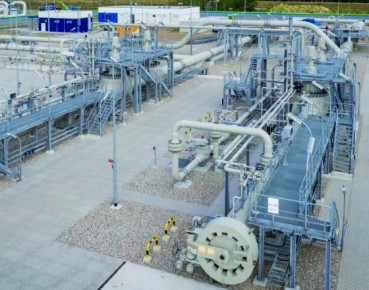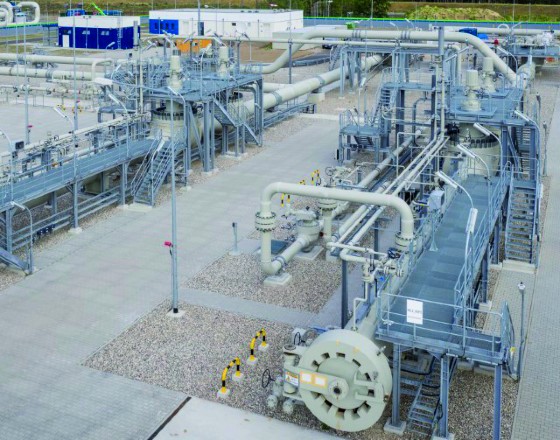
Lubmin, Germany (Nord Stream 2/Axel Schmidt, Public domain)
But the US sanctions still beckon. The Congress is discussing a new sanctions bill that would extend the scope of already imposed sanctions, targeting the insurers, companies working on related pipe-laying activities, such as trenching, site preparation, rock placement and those involved in the modernization or tethering of the vessels.
However, the key provision of the newly proposed sanctions is to hit entities (so-called “classification societies”) that provide certification services for Nord Stream 2. Norway’s DNV was assigned to perform this role on Nord Stream 2, and the whole pipeline has been designed and built according to DNV standards. Some believe it is highly questionable whether it will be possible for the Russians to meet NS2 compliance with DNV standards.
“Denmark’s decision makes it definitely much easier and cheaper for Russia to complete Nord Stream 2,” said Anna Mikulska from Rice University in Texas. “Now, the question is whether the already existing US sanctions would then apply to Gazprom,” she said, noting that Akademik Czersky is now owned by the Samara Thermal Energy Property Fund (STIF), whose operating entity was Gazprom Fleet, a subsidiary of Gazprom. The STIF is on the list of Gazprom-affiliated groups and the vessel remains under operational management of Gazprom Fleet, which is apparently already included in some less stringent sector sanctions.
“But the question is not only what these sanctions mean for NS2 and Europe but also what they mean for the US,” Ms. Mikulska added. “While domestically the sanctions could provide some benefits for American policy makers and politicians supporting them, in terms of foreign policy they may become an issue.”
“In Germany, there is disbelief over the US sanctions package, in particular after Germany worked hard to secure Russian gas transits through Ukraine,” said Kirsten Westphal, an energy expert at the German Institute for International and Security Affairs (SWP). “There is bipartisan US support to stop the pipeline and some very harsh anti-Germany rhetoric from Mr. Trump,” she said.
During a recent debate in the Bundestag (German parliament), government representatives claimed sanctions against the investment would be treated as interference in German and European sovereignty and threatened that the EU would impose retaliatory sanctions. “The narrative forming in Germany is that sanctions would also have a very serious economic impact this time,” Ms. Westphal said. “At the end of the day, it is also a EU regulation and the 2019 amendment of the Gas Directive, which is simply being undermined,” she added.
Mere technicalities
The two Russian vessels able to conduct the work are both moored in the German port of Mukran: pipe-layer Akademik Cherskiy and the anchored barge, Fortuna. In May, Gazprom brought Akademik Cherskiy to the Baltic Sea from the Russian far east. It is the only modern ship in Russia for laying submarine gas pipelines that is also equipped with a dynamic positioning (DP) system, which allows ships to determine their position and perform precise maneuvers without the use of anchors. Danish law requires companies building undersea infrastructure to use vessels equipped with a DP system, to avoid the huge stocks of chemical weapons left on the seabed after WWII. But, according to Russian media, to complete the laying of Nord Stream 2, Fortuna — which does not have a DP system — is also needed.
Gazprom may try to use the two vessels simultaneously, Mateusz Kubiak, an oil and gas expert with Warsaw-based consultancy firm Esperis, speculated. “This, however, would be a very unusual option and might be quite risky,” he said. “And for sure Fortuna would do that at a very low speed,” he added.
The best laid plans
Russia’s energy minister, Aleksandr Nowak, said he had no doubt Nord Stream 2 would be completed on time. But not all agree. Ms. Mikulska points out Germany’s Bundesnetz decision to reject Nord Stream 2’s application to be exempted from the EU directive, after the EU’s Court of Justice rejected applications filed by the pipeline owners, Nord Stream 1 AG and Nord Stream 2 AG, for annulment of the relevant EU Directive. Gazprom is also involved in antitrust proceedings initiated in 2018 by Poland’s Office of Competition and Consumer Protection (UOKiK) against all companies involved in financing the pipeline. “These are formidable issues likely to delay the pipeline and make it more expensive,” Ms. Mikulska said.
“The question is if it is worth creating another spat between the EU and the US — especially that both have not seen eye to eye in recent years. The differences between allies can be definitely exploited not only by Russia but also by China to detriment of both the US and the EU,” she said, adding there were other ways the US could make it more difficult for Russian gas to gain ground in Europe, such as helping countries in the EU to diversify their natural gas infrastructure, including higher LNG capacity and interconnections.
Some 1,230 kilometers (775 miles) in length, Nord Stream 2 is set to run from Russia’s Ust-Luga, but is now on hold around 160 kilometers off the German coast after the US sanctions came into force forcing Swiss-Dutch company Allseas to withdraw its ship. The EUR10bn pipeline would double Russia’s direct export capacity to Germany as a first entry point to the EU to 110 billion cubic meters (bcm) per year.


